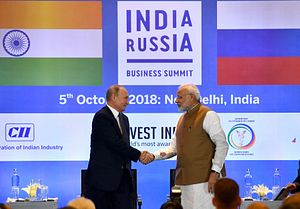India and Russia inked a much anticipated $5.5 billion defense deal for the procurement of five regiments of Russian-made Almaz-Antei S-400 Triumf air defense systems (NATO reporting name: SA-21 Growler) during a ceremony witnessed by Indian Prime Minister Narendra Modi and Russian President Vladimir Putin on October 5. The contract was signed after the conclusion of talks between the Indian prime minister and Russian president during the 19th India-Russia bilateral annual summit held in New Delhi.
The conclusion of the S-400 agreement will complicate New Delhi’s deepening strategic relations with Washington, given the latter’s threat to impose economic sanctions on countries engaging in “significant transactions” (defined as above $15 million) with the Russian defense industry under U.S. legislation known as the Countering America’s Adversaries Through Sanctions Act (CAATSA).
CAATSA, which came into effect in January 2018, is aimed at punishing Russia for its alleged interference in the 2016 presidential elections and mandates the imposition of economic sanctions on countries importing Russian military hardware. However, the Trump administration has been given authority under this this year’s U.S. National Defense Authorization Act (NDAA) to waive sanctions in certain circumstances pertaining to Russian legacy systems that costs less than $15 million.
Technically this would not apply to the S-400 — touted as one of the most advanced and effective long-range interceptor-based air defense systems in the world. However, it is still unlikely that India will be subject to financial sanctions as a result of the procurement as the United States does not want to jeopardize the evolving strategic partnership between the two countries. Various U.S. officials, including U.S. Secretary of Defense James Mattis, have openly spoken out against possible sanctions on India.
Furthermore, according to a former senior Indian government official speaking to The Diplomat on the condition of anonymity, senior U.S. administration officials have repeatedly signaled in conversations that New Delhi will not be punished for the purchase.
In September, the United States imposed sanctions on the People’s Liberation Army’s (PLA) Equipment Development Department (EDD) for China’s procurement of S-400 systems and Sukhoi Su-35S (NATO reporting name: Flanker-E) fourth generation, twin-engine, multirole fighter aircraft.
Notably, China was sanctioned for taking delivery of the S-400s and Su-35S fighter jets and not for the signing of the contract, which took place back in 2015. Consequently, given that the first S-400 delivery from Russia to India is not expected until 2020, the U.S. government will not have to immediately react to the conclusion of the sales agreement this week. Additionally, this will likely not be the last Indian purchase of Russian military equipment , despite New Delhi diversifying its military imports.
Moscow has been New Delhi’s largest defense supplier since the 1960s, accounting for 68 percent of India’s arms imports from 2012 to 2016, according to the Stockholm International Peace Research Institute (SIPRI). However, U.S. arms exports to India rose by 557 percent between 2008-2012 and 2013-2017, according to SIPRI.
What has still not been made public is the exact number of systems sold, including the number of launchers and type of missiles to be delivered under the recently concluded contract.
The standard S-400 battery consists of four transporter erector launchers (TELs) with four launch tubes per TEL, in addition to long-range surveillance radar target acquisition and engagement (fire control) radar systems and a command post (vehicle). In the Russian military, two batteries make up a S-400 battalion (also known as a S-400 division), whereas a S-400 regiment consists of two battalions.
While reports have repeatedly referred to five S-400 regiments or squadrons — the S-400s are reportedly destined for the Indian Air Force — these units, however, would be battalion-sized according to the Russian military structure. Consequently, the likely number of TELs to be delivered will be around 30, including an unknown number of missiles. As I explained previously:
In comparison to its predecessor, the S-300, the S-400 air defense system features an improved radar system and updated software; it can purportedly fire four new types of surface-to-air (SAM) missiles in addition to the S-300’s 48N6E, a vertical tube launched, solid fuel, single stage SAM with an estimated range of 150 kilometers (93 miles), and the improved 48N6E2 missile with a reported range of 195 kilometers (121 miles)…
The S-400 is also armed with an improved variant of the 48N6E2 with an alleged range of 250 kilometers (160 miles). The air defense system can also fire two additional missiles, the 9M96E and 9M96E2 with respective ranges of 40 km (25 miles) and 120 km (75 miles). Improved S-300 air defense systems such as the S-300PMU-2 Favorite … can purportedly also fire the 9M96E and 9M96E2.
The S-400’s latest and most advanced missile system, the 40N6 SAM — the export variant of the missile is designated 40N6E — will most likely not be part of the initial delivery. (Indeed, it is unclear whether the missile was ever part of the deal.) The 40N6E has a purported operational range of 400 kilometers (248.5 miles) and can destroy targets up to an altitude of 30 kilometers.
The S-400s are expected to be fully integrated with the Indian Air Force’s IACCS (integrated air command and control system), an automated command and control system for air defense, which integrates the service’s air and ground-based air sensors and weapons systems.
































